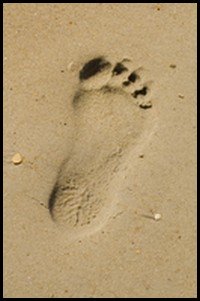Practical Ways to Reduce a Carbon Footprint
"We have plenty of open spaces and unused land", I hear your say. Yes we do, but our ecological footprint that is dictated to by what we consume in the form of utilities, food and travel is getting bigger and bigger. To the point that with our current lifestyles Australians need in excess of 7.7 hectares of land to sustain them and Americans need 9.6 hectares. And worst of all, I live in a country where we need 11.8 global hectares per person!
And how much land should we be using? With the current population, we should only be using 1.8 hectares of land. If current populations and consumption trends continue, by the mid 2030s we will need the equivalent of two earths to support us. That's a sobering fact, considering we only have one. It stands to reason then, that we cannot keep on living the same lifestyle if we want to conserve resources for the following generations.
So, how is our ecological footprint made up, and how can we reduce our carbon footprint? And do you even know what carbon is?
What is Carbon?
 Carbon
is an element found in all living things; soil, ocean and the air. In
nature there are continuous cycles of life and death of which carbon is
the key element.
Carbon
is an element found in all living things; soil, ocean and the air. In
nature there are continuous cycles of life and death of which carbon is
the key element.Carbon is produced when plants absorb carbon dioxide (CO2) and sunlight in their leaves and water from their roots. These plants are then eaten by animals. Carbon is returned to the atmosphere as carbon dioxide when animals breathe, plants respire and return to the earth when they die and decompose.
However, since the Industrial Revolution of the late 1800s and into the 1900s, the burning of fossil fuels (coal, gas and oil) and the high levels of deforestation throughout the world has increased the amount of carbon dioxide in the atmosphere.
This means that more carbon di oxide is being expelled and less plant matter is available to absorb the gas.
Carbon dioxide is a greenhouse gas that traps heat in the atmosphere. Life on earth would cease to exist without this gas keeping the planet warm, but now there's too much carbon dioxide in the atmosphere and the earth is becoming increasingly hotter like a greenhouse.
Whilst planting trees is a good start, using less fossil fuels is also critical. By making some behavioral changes to our lifestyles like walking or cycling rather than using our cars, using less electricity or buying locally-grown produce are all ways in which we can reduce our carbon footprints.
How to Reduce a Carbon Footprint Generated from Meat and Animal Products
The biggest component of your ecological footprint is made up of meat and animal products at 33%. Even if you are a vegetarian, you would be using more space than a vegan. Production of a single 150 gram serve of meat is estimated to use over 200 liters of water and create 5 kilograms of greenhouse pollution.In addition, to produce one pound of meat, an animal must consume tens of times that weight in grain. Therefore, the land on which the grain is grown is counted in the footprint. This grain must also be shipped and the meat processed, which adds to the growing footprint.
Practical Ways - By eating one less serving of meat a week, in a year you would save up to 10,000 liters of water and 300 kg of greenhouse pollution!
How to Reduce a Carbon Footprint Generated from Clothing
Clothing make up 14% of the footprint. Do you buy clothing from recycled materials? How often do you buy new clothes? And have you ever thought about how much water it takes to produce your clothes per year? Well, 150 000 liters to be exact which is made up of the amount of water used in its production, manufacture and transportation. That doesn't include the kilograms of pesticides and fertilizers taken to produce the material.
Practical Ways - Buy fewer clothes and rather repair and mend rather than replacing.
How to Reduce a Carbon Footprint Generated from Housing Construction
11% here!
Practical Ways We all need shelter, but when renovating, buying new or an existing property consider how you can improve its water and energy consumption and go for a greener build. Use local building materials with recyclable content. Don't use fossil fuels and attach water tanks to your roof to store rainwater for your garden. Use solar power and wind turbines. By buying near public transport you can leave your car in the garage and save even further.
How to Reduce a Carbon Footprint Generated from using Other Services
10% here! These include your plumbers, electricians, architects and landscapers.
Practical Ways - Employ green plumbers, green electricians and green architects who are sympathetic to sustainable and green building. When you have your garden landscaped do it with organic material and leave out the chemical fertilizers.
How to Reduce a Carbon Footprint Generated from using Planes and Accommodation
Practical Ways - Limit your plane travel and take eco-holidays where the owners are responsible towards the environment and are looking to provide low-impact holidays. Remember if you are camping or on a picnic to light cooking fires safely, and remove all rubbish when you are done.
How to Reduce a Carbon Footprint Generated from Using Vegetables
8% of your ecological footprint. Going to buy frozen and canned vegetables has taken more resources than buying fresh produce from your local farmer or growing your own.
Practical Ways - If you have a garden or even a balcony, grow your own vegetables and herbs. Use plenty of manure and natural pesticide sprays to kill those bugs and beasties and support your local farmer at your local farm shop or farmers' market. Become a localvore and know the importance of eco conscious biodiversity.
How to Reduce a Carbon Footprint Generated from Manufactured Goods
7% of your ecological footprint goes in manufactured goods.
Practical Ways Think of renting before you buy. This includes power tools, camping equipment, lawnmowers and motorized gardening equipment.
How to Reduce a Carbon Footprint Generated by Cars
Practical Ways - Car pool, take public transport, buy locally and even cycle or walk to work if you can. By cycling or walking you are getting the additional benefit of exercise.
How to Reduce a Carbon Footprint Generated by Using Furniture and Small Appliances
2% of your ecological footprint is spent on furniture and small appliances.
Practical Ways - Do you really need the latest deep-fryer or popcorn maker? Can you not make do with a deep pot for both? Limit your small appliances and see if you can buy wooden furniture that has come from well-managed forests that are sustainable. Stay away from timber that has come from rain-forests and the like.
How to Reduce a Carbon Footprint using Beauty Products and Toiletries
1% of your ecological footprint. You would be shocked to know that with all the additional chemicals, fragrances and colors added to beauty products and toiletries these days, the average woman could end up with 2 kg of synthetic chemicals in her body through skin absorption.
Practical Ways - Read our section on how to make your own natural beauty products to see how you can make cosmetics naturally and safely for all your beauty needs.
FINAL OUTCOME? SO JUST HOW BIG IS OUR ECOLOGICAL FOOTPRINT?
A sustainable lifestyle is one that does not use more natural resources at a faster rate than the earth makes available. We should make wise decisions about our environment and always try to recycle where possible. We should all be aiming towards a more sustainable lifestyle.So what is your own carbon footprint? Why don't you head over to our Carbon Footprint Calculator and find out for yourself!
Did you find this page helpful?
Sharing is a way of saying, "Thanks!"
Follow Us and Keep Up to Date
BOOKS ON HOW TO REDUCE OUR ECOLOGICAL FOOTPRINT
You can Add your Own Comments and Pages on the Ecological Carbon Footprint!
We have lots of pages where you can contribute to throughout this homesteading website. We love hearing from our readers, and hope you will be one of those we hear from too. Look around our homesteading website. If you have any comments on ecological carbon footprints, and what you do to reduce your ecological footprint we would love to hear about it!
Leave a Comment
Do you have anything that you would like to add after reading this page? We would love to hear your thoughts. If you can add additional information to what has been written here you will be adding value to the website! No need to have any special skills - just type and submit. We will do the rest!








New! Comments
Do you have something of value to add? Leave me a comment in the box below.